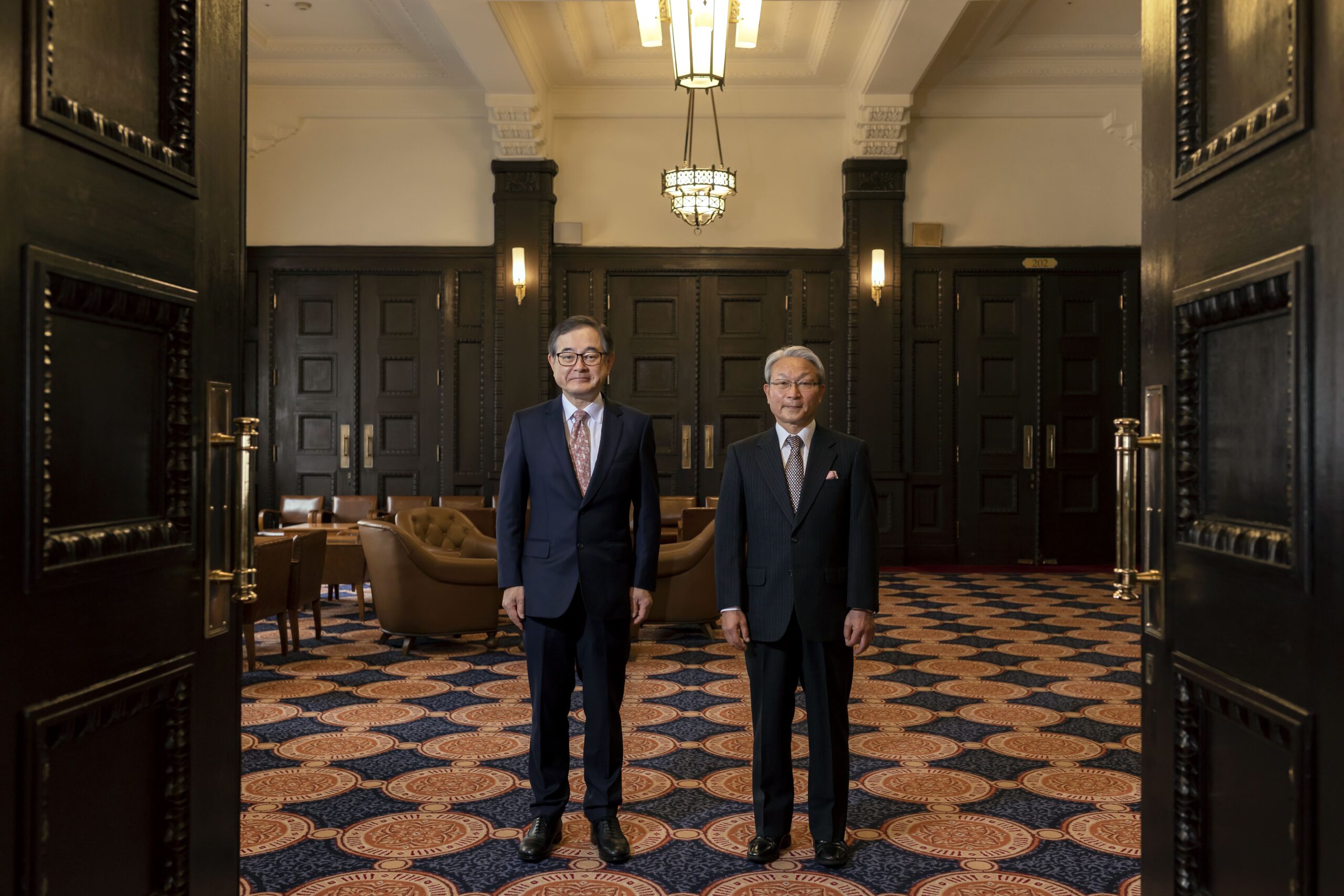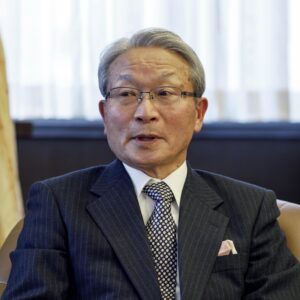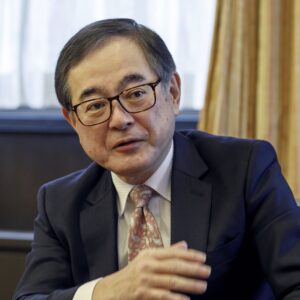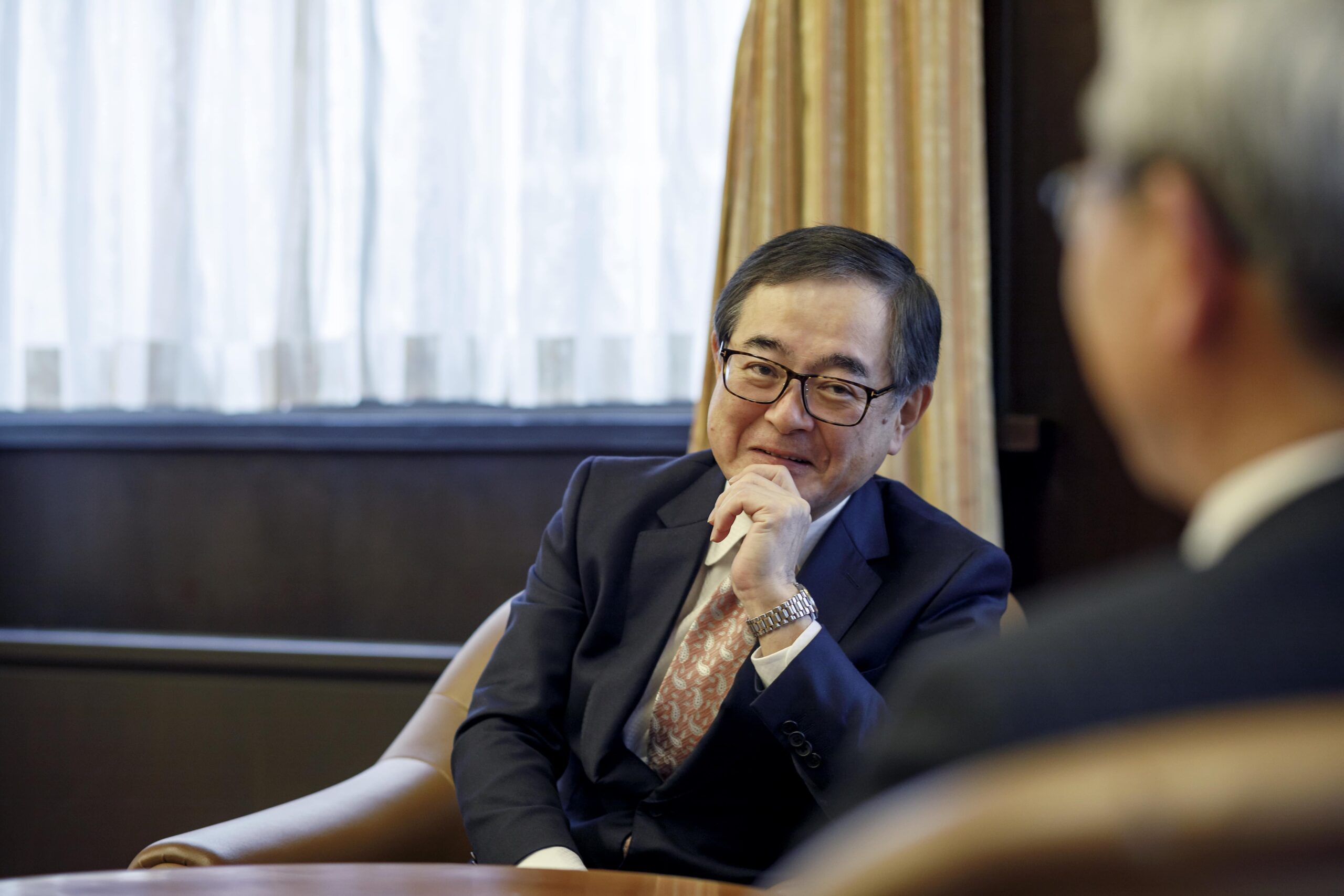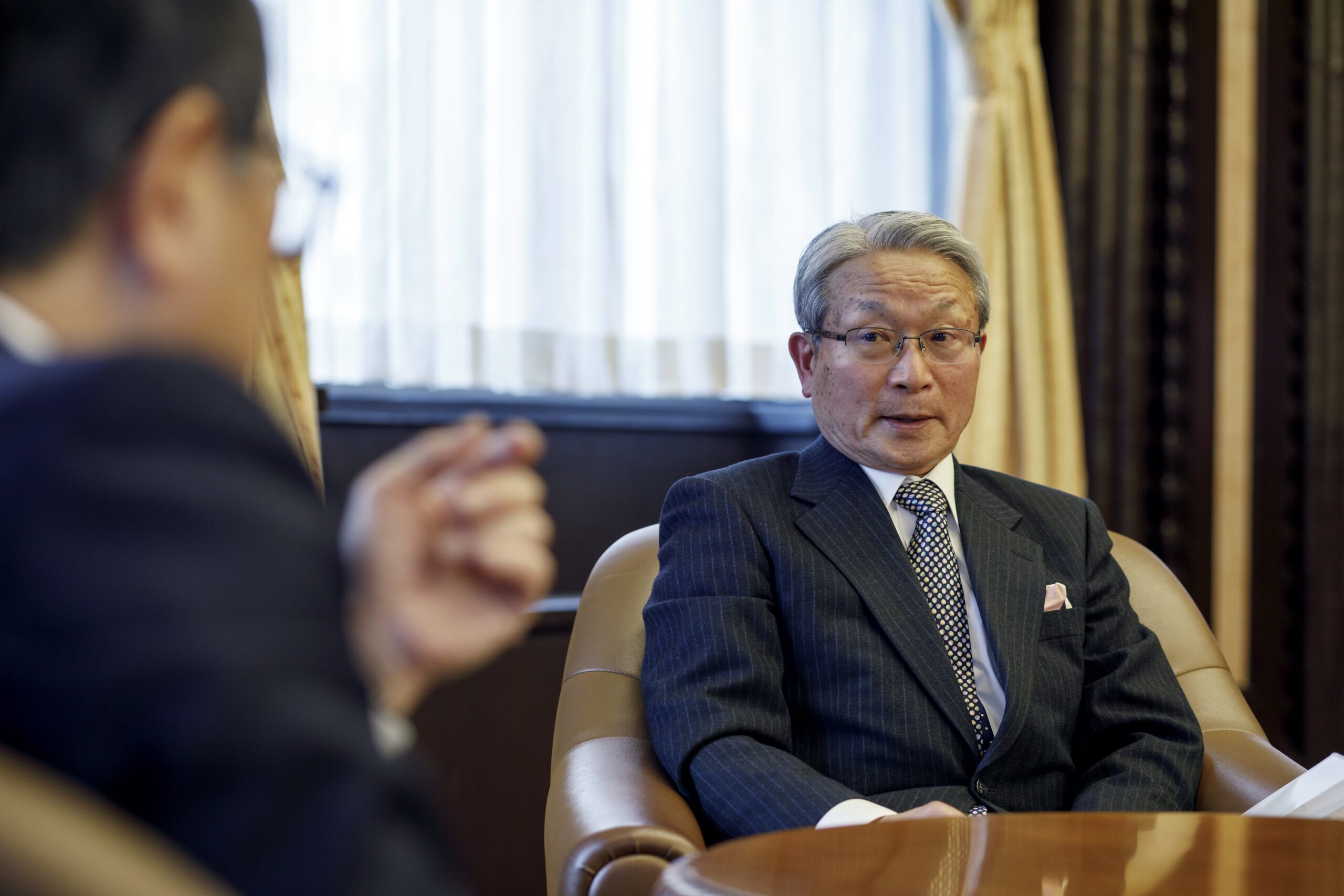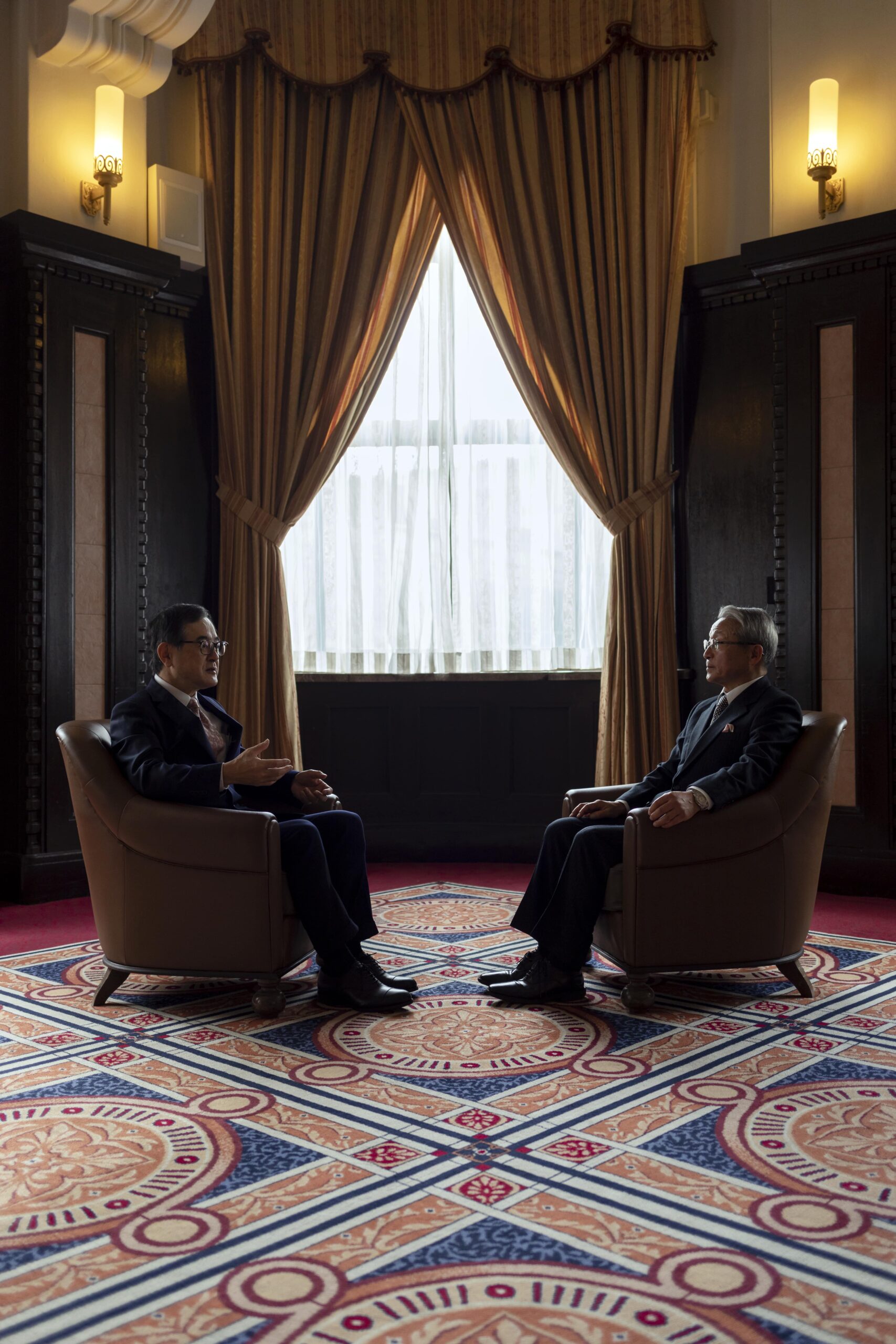Promoting communications and a sense of belonging will lead to the growth of the organization
University News | October 27, 2021
This interview was published in the Spring 2021 issue of Litterae Populi. The full issue can be found here.
Mr. Kazuo Sugie has had experience in a wide range of practical operations, including research, manufacturing, planning and sales, for 30 years since he joined Dainippon Ink and Chemicals, Inc. (presently DIC Corporation). After becoming an executive, he implemented management reforms under the management vision of “Color and Comfort by Chemistry” and led the sustainable growth of the company. He holds various positions and is active at the forefront of society.
President Kiyohiro Houkin, who has been working energetically to make Hokkaido University like no other university since assuming office in October 2020, interviewed Mr. Sugie, a Hokkaido University alumnus, about his life and corporate philosophy and about the partnership between the University and the alumni association.
- Kazuo Sugie (Guest)
-
Director (Standing Audit & Supervisory Committee Member), Sapporo Holdings Limited
Director General, Central Council for the Promoting of Industrial Education
Director, Asia/Pacific Cultural Centre for UNESCO
Born in Hokkaido in 1945. Graduated from the Muroran Institute of Technology Faculty of Engineering. Completed the master’s degree of the Hokkaido University Graduate School of Engineering. Joined Dainippon Ink and Chemicals, Inc. (presently DIC Corporation) in 1970. Became a director in 2001, the president in 2009, the chairman in 2012 and an advisor in 2015. Active on the front lines of society even after retirement. Became the president of the Hokkaido University Elm Alumni Association in July 2019.
- Kiyohiro Houkin (Interviewer)
-
President, Hokkaido University
Born in Hokkaido in 1954. Graduated from Hokkaido University School of Medicine. Doctor (medicine) (Hokkaido University). Worked for Hokkaido University Hospital and other facilities since 1979. After working as a visiting researcher at the University of California, Davis, became an assistant professor at the Hokkaido University Graduate School of Medicine in 2000, professor of Sapporo Medical University School of Medicine in 2001 and professor of the Hokkaido University Graduate School of Medicine in 2010. After becoming the director of Hokkaido University Hospital/ vice executive of Hokkaido University in 2013 and the director of Hokkaido University Hospital/vice president of Hokkaido University in 2017, assumed the present position in October 2020.
Dedication to study during school years
Houkin: First, where are you from? Could you also tell me your story from boyhood to enrollment in Hokkaido University?
Sugie: I come from Urahoro Town in the Tokachi region of Hokkaido. I was the kind of child who’d always ask adults “Why?” A town high school had just opened, so I entered as one of the first students. Being a small and local school, all the students were friends and had fun. After that, I entered Muroran Institute of Technology. In my fourth year, I heard about graduate school from a teacher who came from Hokkaido University as a lecturer every week, and I decided to aim for it. I studied the hardest during that time as it was very difficult to enter Hokkaido University from another university.
Houkin: I don’t think many people went to graduate school in those days. You must’ve been a hard worker.
Sugie: As I felt chemistry was easy after memorizing the periodic table of the elements, I was good at the subject since junior high school and high school. I also liked to read since childhood and I read many books, so I was also good at contemporary Japanese language. Although I wasn’t good at subjects that required memorization, I studied English very hard.
Houkin: What research did you conduct in the master’s degree? And how did you decide your career path after completing the degree?
Sugie: I conducted research on extracting compounds from oil components. I formulated a theory, wrote a theoretical equation and proved it in an experiment by myself. It was more like chemical engineering. Because the environment allowed me to freely conduct research, I did everything—from determining a theme to making devices. I remember feeling happy when a teacher at my master’s thesis defense complimented me, saying “What you’re doing is interesting. It can be applied to the fabrication of industrial devices.” I wanted to keep engaging in chemical research after completing the course, so I joined Dainippon Ink and Chemicals, Inc. (presently DIC Corporation).
Houkin: At Hokkaido University, ICReDD (the research center presented in Feature 1) is promoting the development of chemical reactions that can revolutionize society. Listening to your story, I truly feel that chemistry has been a characteristic strength of Hokkaido University, and one that continues to this day.
Sugie: I think Hokkaido University’s research can lead in the field of chemistry, such as the work of Professor Akira Suzuki, who won the Nobel Prize. As many companies seem to be having trouble determining a future direction, I expect Hokkaido University to lead joint research with sponsoring companies.
Consumer value in business development
Houkin: What kind of work did you do after entering the company?
Sugie: I entered the company to conduct research, but I was in the research department for only four and half years. After that, I was transferred to nine different departments over the course of 30 years, including production and planning, until I became an executive. I wasn’t good at communications, so I started out by choosing science; even so, I worked as a supervisor of a manufacturing site and in the sales and marketing departments. For decades, every time I changed positions I initially did not like the job.[laughs].
Houkin: You must’ve had all kinds of experiences.
Sugie: When I was at a manufacturing site, I was called in even on my days off if there were out of specification products. I felt that defective goods owed to the workers’ lack of a sense of identity as manufacturers, so I held workshops every week. As a result, they came to understand the meaning of product standards and purposes, and they came to identify with and feel responsible for the goods. When I was in the marketing section, I wasn’t good at talking with clients. Then I changed my approach to let others talk and just listen to them. When it comes to their specialties, clients have plenty to talk about and they even give me ideas about work. When I met insurance salespersons, I also felt that trust was important and that selling goods meant having customers buy your personality.
Houkin: Were you influenced by anyone, or can you remember any anecdotes from your activities at the company?
Sugie: When I visited the president of Yamazaki Baking Co., Ltd., I saw a poster with Peter Drucker’s words: “What is our business? Who is our customer? What does our customer consider value?” I got the poster from the president and put it in my office when I became the president of my company. Although Dainippon Ink had about a third of the global market share for printing ink, our business of producing ink for newspapers, magazines and other paper printing was in the red. The clients of an ink company are printing companies, and they see value in ink with superior printing characteristics with low price. Clients of printed matter are consumers who see value in the acquisition of information. The method of information transmission has been shifting from print to digital, and we’ve shifted our focus to R&D to further improve chemical products used for information devices, namely, liquid crystal compounds and color filter pigments that are already in our product line. Although sales volumes have decreased, profit margins have increased. By following the words of Drucker and considering what consumers value, we’ve managed to change the company’s composition. On our 100th anniversary, we changed our name to DIC. I instructed the section heads and chiefs, who would be the next generation leaders, to think of a new management vision. The result was “Color & Comfort by Chemistry.” We were able to change our direction so as to provide sustainable products to the world by utilizing most of the company’s management resources, thanks to Drucker’s words, who made me realize that there would be eternal demand for the value of “colors,” and not just of pigments as substances.
Solid partnerships to make the university like no other
Houkin: You’re serving as the president of the Hokkaido University Elm Alumni Association. Could you tell me your ideas about alumni activities?
Sugie: For graduates, I think an alma mater is like a family . I think everyone wants to contribute to their family home, but when it comes time to make donations or conduct joint research, they hesitate to take action. First, it’s necessary to foster a sense of belonging to Hokkaido University. If there’s a good reason,alumni will cooperate. For instance, it is important for the university to work on the purpose of the donation and research initiatives for the society. I want to keep supporting the university by bridging the gap between the university and alumni.
Houkin: Thank you. Focus has recently been placed on engagement management, that is, the establishment of trust-based relationships in which we interact with organizations on equal terms. Against such a background, the Elm Alumni Association is very important as a group of people sharing the same feelings and thoughts. A solid partnership with the Elm Alumni Association is essential for the consolidation of the management base and the promotion of industry-university collaboration, I believe that this time of your presidency is an opportunity to bring about changes.
Sugie: For the future of Japan, I want the national government to invest more in universities. At the same time, the acquisition of external funds is also necessary for financial independence as a corporation. Since you’ve clearly presented your vision for the revitalization and development of Hokkaido University and you’ve placed the importance of governance in management, what you need now is the community’s support. If I ask businesspersons what they think about Hokkaido University alumni, most say they’re quiet. Another thing that I often hear people say is, “Many graduates of Hokkaido University play active roles overseas.” Others say that they have indomitable and independent spirits. I think it’s because of the historical background that people
came from all over Japan to colonize Hokkaido. No other university has so many students coming from all over the country. Looking at the number of international students, it is also a very diverse university. Considering that, Hokkaido University has sufficient capacity to rank among leading universities in the world.
Houkin: Thank you. Lastly, could you give a message to students and graduates?
Sugie: What kind of people are leaders? A leader and a head are apparently different. Being a head is simply about a hierarchical relationship. If one simply follows orders from the head and things don’t work out, the head subordinate will just say that the head’s order was a mistake. I believe the most important thing for a leader is to have the followers willingly work with the leader. The basis of my idea is that we can’t work the way we want without the help from those around us, because a person’s ability is limited. That’s why I want students of Hokkaido University to become leaders who value teamwork. I think the university’s Nitobe College education program is truly a step ahead of global education. Hokkaido University can be a global hub university in professional education, including leadership education. I want to keep supporting Hokkaido University as the family home of alumni.
Houkin: The phrase “Boys, be ambitious” has various interpretations, and I think it’s connected with leadership education and entrepreneurship. I hope for your continued guidance, as I feel the need to advance by demonstrating the characteristics of the university a little more clearly in collaboration with the Elm Alumni Association. Thank you very much for today.
This interview was published in the Spring 2021 issue of Litterae Populi. The full issue can be found here.

